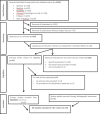Prevalence of psychotic disorders and its association with methodological issues. A systematic review and meta-analyses
- PMID: 29649252
- PMCID: PMC5896987
- DOI: 10.1371/journal.pone.0195687
Prevalence of psychotic disorders and its association with methodological issues. A systematic review and meta-analyses
Abstract
Objectives: The purpose of this study is to provide an updated systematic review to identify studies describing the prevalence of psychosis in order to explore methodological factors that could account for the variation in prevalence estimates.
Methods: Studies with original data related to the prevalence of psychosis (published between 1990 and 2015) were identified via searching electronic databases and reviewing manual citations. Prevalence estimates were sorted according to prevalence type (point, 12-months and lifetime). The independent association between key methodological variables and the mean effect of prevalence was examined (prevalence type, case-finding setting, method of confirming diagnosis, international classification of diseases, diagnosis category, and study quality) by meta-analytical techniques and random-effects meta-regression.
Results: Seventy-three primary studies were included, providing a total of 101 estimates of prevalence rates of psychosis. Across these studies, the pooled median point and 12-month prevalence for persons was 3.89 and 4.03 per 1000 respectively; and the median lifetime prevalence was 7.49 per 1000. The result of the random-effects meta-regression analysis revealed a significant effect for the prevalence type, with higher rates of lifetime prevalence than 12-month prevalence (p<0.001). Studies conducted in the general population presented higher prevalence rates than those carried out in populations attended in health/social services (p = 0.006). Compared to the diagnosis of schizophrenia only, prevalence rates were higher in the probable psychotic disorder (p = 0.022) and non-affective psychosis (p = 0.009). Finally, a higher study quality is associated with a lower estimated prevalence of psychotic disorders (p<0.001).
Conclusions: This systematic review provides a comprehensive comparison of methodologies used in studies of the prevalence of psychosis, which can provide insightful information for future epidemiological studies in adopting the most relevant methodological approach.
Conflict of interest statement
Figures
References
-
- GBD 2016 Disease and Injury Incidence and Prevalence Collaborators. Global, regional, and national incidence, prevalence, and years lived with disability for 328 diseases and injuries for 195 countries, 1990–2016: a systematic analysis for the Global Burden of Disease Study 2016. Lancet 2017; 390: 1211–59. doi: 10.1016/S0140-6736(17)32154-2 - DOI - PMC - PubMed
-
- Baxter AJ, Patton G, Scott KM, Degenhardt L, Whiteford HA. Global epidemiology of mental disorders: what are we missing? PLOS ONE 2013; 8: e65514 doi: 10.1371/journal.pone.0065514 - DOI - PMC - PubMed
-
- Chong HY, Teoh SL, Wu DB, Kotirum S, Chiou CF, Chaiyakunapruk N. Global economic burden of schizophrenia: a systematic review. Neuropsychiatr Dis Treat 2016; 12: 357–373. doi: 10.2147/NDT.S96649 - DOI - PMC - PubMed
-
- MacGrath JJ, Charlson F, Whiteford HA. Challenges and options for estimating the prevalence of schizophrenia, psychotic disorders, and bipolar disorders in population surveys School of Public Health. 2016. Standing Committee On Integrating New Behavioral Health Measures Into The Substance Abuse And Mental Health Services Administration’s Data Collection Programs; Retrieved from http://sites.nationalacademies.org/cs/groups/dbassesite/documents/webpag...
-
- Goldner E, Hsu L, Waraich P, Somers J. Prevalence and incidence studies of schizophrenic disorders: a systematic review of the literature. Can J Psychiatry 2002; 47: 833–843. doi: 10.1177/070674370204700904 - DOI - PubMed
Publication types
MeSH terms
LinkOut - more resources
Full Text Sources
Other Literature Sources
Medical





